Preface for instructors
Dear Colleagues:
As college teachers, we have a far-reaching mission. We prepare students to write for different purposes, for different audiences, and in different genres and media. We show students how to read critically and write effectively, preparing them to join ongoing research conversations as contributors (not just as consumers) of ideas. What we teach is at the very core of students’ college experience. For academic success, no skill is more critical than effective writing.
This new edition of A Writer’s Reference grows out of my thirty years as a writing teacher and from many conversations with college faculty across disciplines. In all these conversations, I hear a similar theme: Writing is the core of a student’s success, no matter the field of study. Teachers speak about ambitious assignments to teach students how to think and write clearly and precisely, how to interpret evidence and data, and how to enter research conversations with the requisite skills to manage information and avoid plagiarism. And faculty across disciplines all speak about the need for their students to have a reliable handbook to help them understand the expectations of college writing assignments and succeed as writers.
I wanted the eighth edition to capture the energy and creativity that surround conversations about student writing, wherever they take place, and to provide students with a trusted reference that supports their development as writers. I also wanted the eighth edition to align easily with course goals and program outcomes, so I spent a good deal of time reviewing such documents and talking with faculty about how A Writer’s Reference can help them meet their goals. We all have high expectations for the writers in our courses; assigning a handbook designed specifically to meet these expectations makes possible both our mission and our students’ success.
Paging through A Writer’s Reference, you’ll discover features inspired by my conversations with teachers and students. One such feature is an emphasis on the relationship between reading and writing. Turn to tabbed section A to see new material that helps students read critically and write insightfully, engage with print and multimodal texts, and move beyond summary to analysis. The eighth edition shows students how to read carefully to understand an author’s ideas, how to read skeptically to question those ideas, and how to present their own ideas in response.
In developing the eighth edition, I wanted students to have even more tools to support the challenges they face as research writers: turning topics into questions, finding entry points in debates, and evaluating, integrating, and citing sources. In particular, I wanted to help students who are assigned to write an annotated bibliography, a core academic genre. In the eighth edition, students will find five new writing guides, helpful tools that offer step-by-step instruction for completing common college writing assignments, including writing an annotated bibliography.
A goal of the eighth edition was to develop a handbook that saves teachers’ time and increases students’ learning. I’m happy to say that teaching with A Writer’s Reference has become easier than ever. The eighth edition is now available with LaunchPad—a system that includes both a print handbook and e-Pages. For the e-Pages, I’ve written prompts and collaborative activities called “As you write” to help students apply handbook advice to their own drafts and to offer practice with thesis statements, research questions, peer review, and more. The e-Pages also include videos and LearningCurve, game-like adaptive quizzing—all easily assignable. Keep reading for more about the media.
As college teachers, we help our students develop as thinkers and writers. I can’t imagine work more important than this. Some years ago, a student told me that her first-year writing course encouraged her to become a person with things to say. I love these words and the hope they express that a writing course may have such a sustaining influence on one student’s life. I bring certain beliefs to A Writer’s Reference: that all students will learn to read deeply and write clearly, that they will find in their reading ideas they care about, and that they will write about these ideas with care and depth.
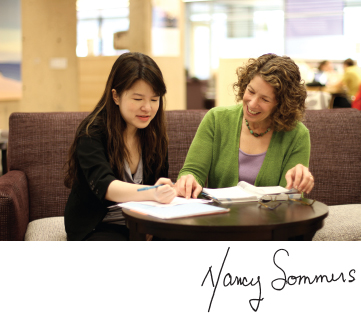
What’s new in this edition?
An emphasis on critical reading. Substantially revised material in tabbed section A, “Academic reading, writing, and speaking,” emphasizes reading as the foundation of every college research and writing assignment. The handbook offers students a reading process, teaching them to read traditional and multimodal texts, research sources, their own work, and the work of their peers critically and reflectively.
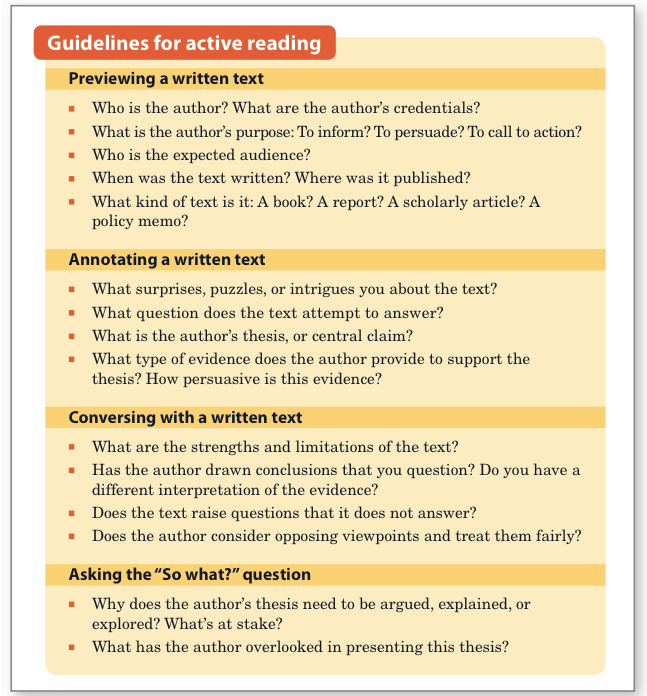
Help with analyzing multimodal texts and composing in new genres. A new chapter about reading and writing about multimodal texts introduces new genres and practical strategies for analyzing these genres. Throughout the book, writing guides give tips for composing college assignments as podcasts, presentations, Web sites, and other alternatives to the traditional essay. New discussions of genre and sample papers in new genres (literacy narrative and reflective letter) align the book more closely with the goals of writing programs and the 2014 Council of Writing Program Administrators (WPA) outcomes.
Paraphrasing sources: strategies for multilingual/ESL writers. New content includes advice about paraphrasing sources effectively. This new section moves students away from the practice of word-by-word substitution and offers strategies for understanding and presenting another writer’s meaning.
Practical writing guides. Five new writing guides help students compose common assignments: argument essays, analytical essays, annotated bibliographies, reflective cover letters, and literacy narratives. The guides clarify the expectations of the genre; provide a step-by-step path as students explore, draft, and revise; and lay a foundation for writing in multiple disciplines.
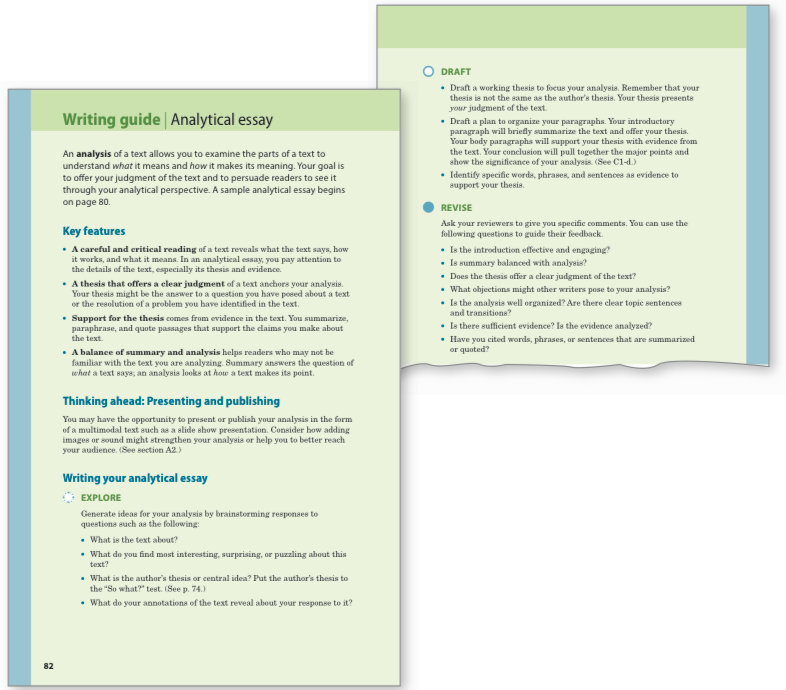
Research and documentation advice fit for any college course. Substantially revised sections teach researchers to find an entry point in a debate and develop authority as a researcher. New advice on writing a research proposal gives practical help that’s useful across the curriculum. And because some sources are difficult to cite, new how-to boxes address authorship and new types of sources such as course materials and reposted Web content.
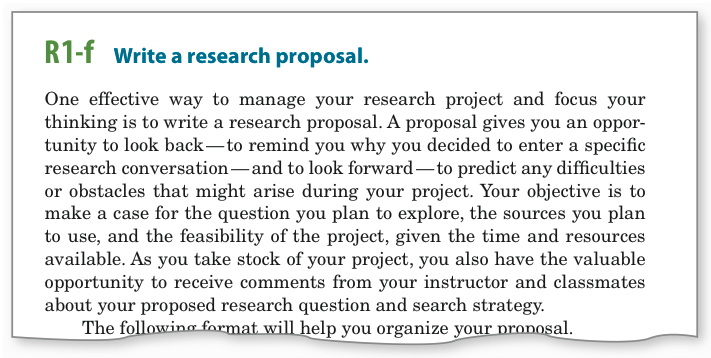
New guidelines for speaking effectively. A new section, A5, prepares students to remix, or adapt, their writing for delivery to a live audience, with emphasis on writing for the ear instead of for the eye.
Engaging new media: LaunchPad. A Writer’s Reference is now available with LaunchPad, which includes a full e-Book that’s easy to assign—as well as interactive e-Pages. The e-Pages, online at hackerhandbooks.com/writersref, engage students with writing prompts, scorable practice exercises, additional sample papers, and LearningCurve’s game-like adaptive quizzes. Easy-to-spot cross-references on the print pages direct students to the e-Pages content in LaunchPad.
- 270 practice exercises help students build skills and strengthen their editing. The exercises report to a gradebook so you can keep track of progress if you choose.
- 36 “As you write” prompts encourage students to apply the lessons of the handbook to their own writing. Students complete brief writing assignments about organizing a paper, drafting thesis statements, working with peers, integrating sources, and other writing topics.
- LearningCurve, game-like online quizzing for 29 topics, builds confidence with sentence-level skills by adapting to students’ responses and adjusting the difficulty level of the quiz items.
- Easy access. If you choose to package LaunchPad with the handbook, students simply use the activation code on the access card when they log in for the first time at hackerhandbooks.com/writersref.
What hasn’t changed?
- The handbook speaks to everything student writers need. Even the most popular search engines can’t give students the confidence that comes with a coherent, authoritative reference that covers the topics they need in a writing course. A Writer’s Reference supports students as they compose for different purposes and audiences and in a variety of genres and as they collaborate, revise, conduct research, document sources, format their writing, and edit for clarity.
- The handbook is easy to use and easy to understand. The explanations in A Writer’s Reference are brief, accessible, and illustrated by examples, most by student writers. The book’s many charts, checklists, tabs, menus, and directories are designed to help users find what they need quickly. And the user-friendly index includes both expert (coherence, ellipsis) and nonexpert (flow, dots) terminology.
- The handbook is coherent, authoritative, and trustworthy. Writing-related resources on the Web offer information, but they don’t offer instruction. With the eighth edition of A Writer’s Reference, students have reference content that has been class-tested by literally millions of students and instructors.
Supplements and media
Visit the catalog page for A Writer’s Reference for a complete list of instructor supplements, including Teaching with Hacker Handbooks, student supplements, videos, e-books (various formats), and other media: macmillanhighered.com/writersref/catalog.
Custom solutions
Many schools opt for a custom edition of A Writer’s Reference. Some programs choose to add a section about course outcomes and policies; others choose to customize by adding student writing from the school; still others decide simply to change the cover to reflect a recognizable campus location and the school name. More and more programs are creating custom editions by including publisher-supplied content—additional tabbed sections on writing about literature, writing in the disciplines, multimodal writing, ESL support, and support for online learners. To discuss custom options for your school, contact your sales representative or visit macmillanhighered.com/catalog/other/Custom_Solutions.
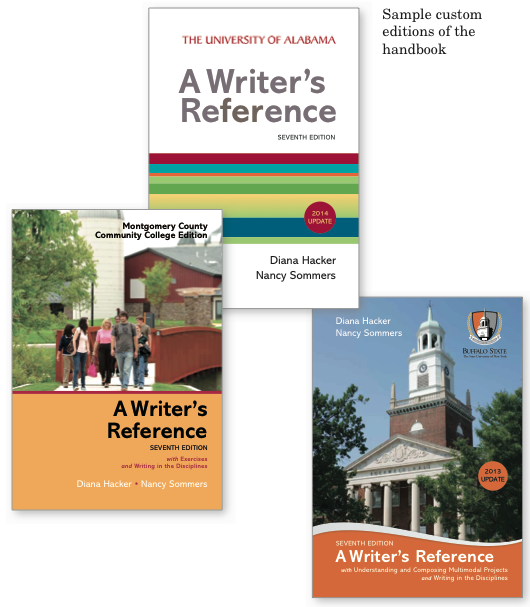
Acknowledgments
I am grateful, as always, for the expertise, enthusiasm, and classroom experience that so many individuals—our very own handbook community—brought to the eighth edition.
Reviewers
For their participation in a focus group at the 2014 Conference on College Composition and Communication, I would like to thank Holly Bauer, University of California, San Diego; Jason DePolo, North Carolina Agricultural and Technical State University; Violet Dutcher, Eastern Mennonite University; Michael Keller, South Dakota State University; and Katherine Tirabassi, Keene State College.
I thank those instructors who offered detailed feedback on various parts of the handbook and its supplements: Marcia Allen, University of Maryland University College; Clinton Atchley, Henderson State University; Phyllis Benay, Keene State College; Wendy Brooks, Palm Beach State College; Elizabeth Browning, Virginia Western Community College; Barbara Butler, Bellevue College; Juan Calle, Broward College; Sybil Canon, Northwest Mississippi Community College; Margaret Cassidy, Adelphi University; Michele Cheung, University of Southern Maine; Vicky Chiu-Irion, University of Hawaii; Jennifer Condon, Iowa Central Community College; James Crooks, Shasta College; Jill Dahlman, University of Hawaii; Jamie Danielson, Iowa Central Community College; Tommie Delaney, Columbus State University; Susan Denning, Clark College; Larnell Dunkley, Harold Washington College; Denise Engler, American River College; Jessica Farrington, Embry-Riddle Aeronautical University; Jan Geyer, Hudson Valley Community College; Ebony Gibson, Clayton State University; Jessica Gordon, Virginia Commonwealth University; Tarez Samra Graban, Florida State University; Gwendolyn Harold, Clayton State University; Vicki Hendricks, Broward College, South Campus; Judy Hevener, Blue Ridge Community College and Stuarts Draft High School; Daniel Hirschhorn, University of Maryland University College (and Montgomery College); Christian Horlick, Virginia Commonwealth University; Barry House, Lincoln Land Community College; Susan Howard, Ivy Tech Community College; Christine Howell, Metropolitan Community College–Penn Valley; Kathryn Ingram-Wilson, Laredo Community College; Laura Jones, Atlanta Technical College; Terra Kincaid, El Paso Community College; Lola King, Trinity Valley Community College; Guy Krueger, University of Mississippi; Mildred Landrum-Hesser, Towson University; Denise Marchionda, Middlesex Community College; Gail Marxhausens, Lone Star College CyFair; John McKinnis, Buffalo State College; Kristopher Mecholsky, University of Maryland University College; Terence Meehan, Northern Virginia Community College; Ashley Moorshead, Community College of Aurora; Joseph Nagy, University of California, Los Angeles; Luis Nazario, Pueblo Community College; Barbra Nightingale, Broward College; Shevaun Donelli O’Connell, Buffalo State College; Gary Olson, Bellevue College; MaryGrace Paden, John Tyler Community College; Jessica Parker, Metroplitan State University Denver; Michelle Paulsen, The Victoria College; Philip Peloquin, Ohio Christian University; Neil Plakcy, Broward College; Holland Prior, Azusa Pacific University; Maria Ramos, J. Sargeant Reynolds Community College; Rolando Regino, Moreno Valley College; Joanna Richter, Laredo Community College; Cortney Robbins, Indiana Tech; Sundi Rose-Holt, Columbus State University; Jay Ruzesky, Vancouver Island University; Donna Samet, Broward College; Andrea Laurencell Sheridan, SUNY Orange; Elizabeth Siler, Washington State University; Colleen Soares, University of Hawaii Leeward Community College; Neil Starr, Nova Southeastern University; Debra Stevens, Las Positats College; Patrick Tompkins, John Tyler Community College; David Wood, Northern Michigan University; Pam Wright, University of California, San Diego.
Contributors
I am grateful to the following individuals, fellow teachers of writing, for their smart revisions of important content: Kimberli Huster, ESL specialist at Robert Morris University, updated Resources for Multilingual Writers and ESL and wrote new material on paraphrasing sources for the Multilingual section of the handbook; and Sara McCurry, professor of English at Shasta College, revised both Teaching with Hacker Handbooks and Strategies for Online Learners.
Students
Including sample student writing in each edition of the handbook makes the resource useful for you and your students. I would like to thank the following students who have let us adapt their papers as models: Ned Bishop, Sophie Harba, Sam Jacobs, Luisa Mirano, Michelle Nguyen, Emilia Sanchez, and Ren Yoshida.
Bedford/St. Martin’s
A comprehensive handbook is a collaborative writing project, and it is my pleasure to acknowledge and thank the enormously talented Bedford/St. Martin’s editorial team, whose deep commitment to students informs each new feature of A Writer’s Reference. Joan Feinberg, director of digital composition and Diana Hacker’s first editor, helped shape the identity of this flagship handbook. Denise Wydra, former vice president for the humanities; Leasa Burton, publisher for composition; and Karen Henry, editorial director for English, have helped guide us with their insights about how the college handbook market is changing and how we can continue to meet the needs of the college writer in the digital age.
Michelle Clark, executive editor, is an author’s dream—a treasured friend and colleague and an endless source of creativity and clarity. Michelle combines wisdom with patience, imagination with practicality, and hard work with good cheer. Barbara Flanagan, senior editor, has worked on the Hacker handbooks for more than twenty-five years and brings attention to detail, keen insights, and unrivaled expertise in documentation and media. Mara Weible, senior editor, brings to the eighth edition her teacher’s sensibility and superb editorial judgment. Thanks to Kylie Paul, associate editor, for assistance with art and permissions, for managing the review process, and for developing several ancillaries, and to editorial assistants Amanda Legee and Stephanie Thomas, who helped with video content and with our student research project. Many thanks to Rosemary Jaffe, senior production editor, for keeping us on schedule and for producing both the print pages and the e-Pages with unparalleled skill and care. And I am grateful to the media team—Harriet Wald, Rebecca Merrill, Marissa Zanetti, Kimberly Hampton, and Allison Hart—for imagining and producing engaging media for the writing course. Insight from Bedford colleagues Jane Helms, Jimmy Fleming, and Nick Carbone, who, like me, spend many, many hours on the road and in faculty offices, is always treasured. Thanks to Linda McLatchie, copy editor, for her thoroughness and attention to detail; to Claire Seng-Niemoeller, text designer, who crafted another open and beautifully designed edition of the book; to Donna Dennison, art director, who has given the book a strikingly beautiful cover; and to Billy Boardman, design manager, for extending the cover design to our many versions.
Last, but never least, I offer thanks to my own students who, over many years, have shaped my teaching and helped me understand their challenges in becoming college writers. Thanks to my friends and colleagues Suzanne Lane, Maxine Rodburg, Laura Saltz, and Kerry Walk for sustaining conversations about the teaching of writing. And thanks to my family: to Joshua Alper, an attentive reader of life and literature, for his steadfastness across the drafts; to my parents, Walter and Louise Sommers, and my aunt Elsie Adler, who encouraged me to write and set me forth on a career of writing and teaching; to my extended family, Sam, Kate, Ron, Charles Mary, Devin, Demian, Liz, and Alexander, for their good humor and good cheer; and to Rachel and Curran, Alexandra and Brian, witty and wise beyond measure, always generous with their instruction and inspiration in all things that matter. And to Lailah Dragonfly, my granddaughter, thanks for the joy and sweetness you bring to life.
Nancy Sommers